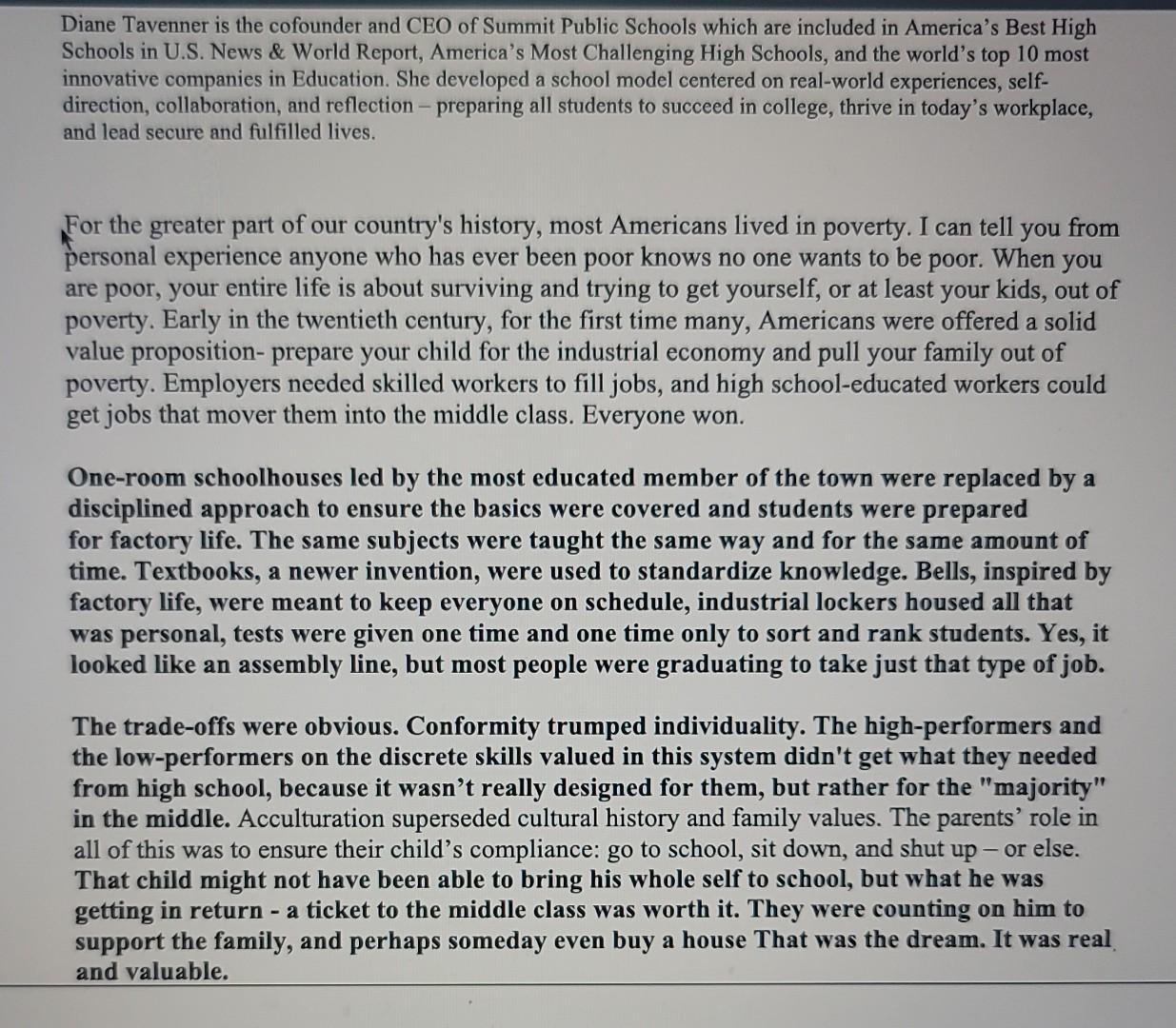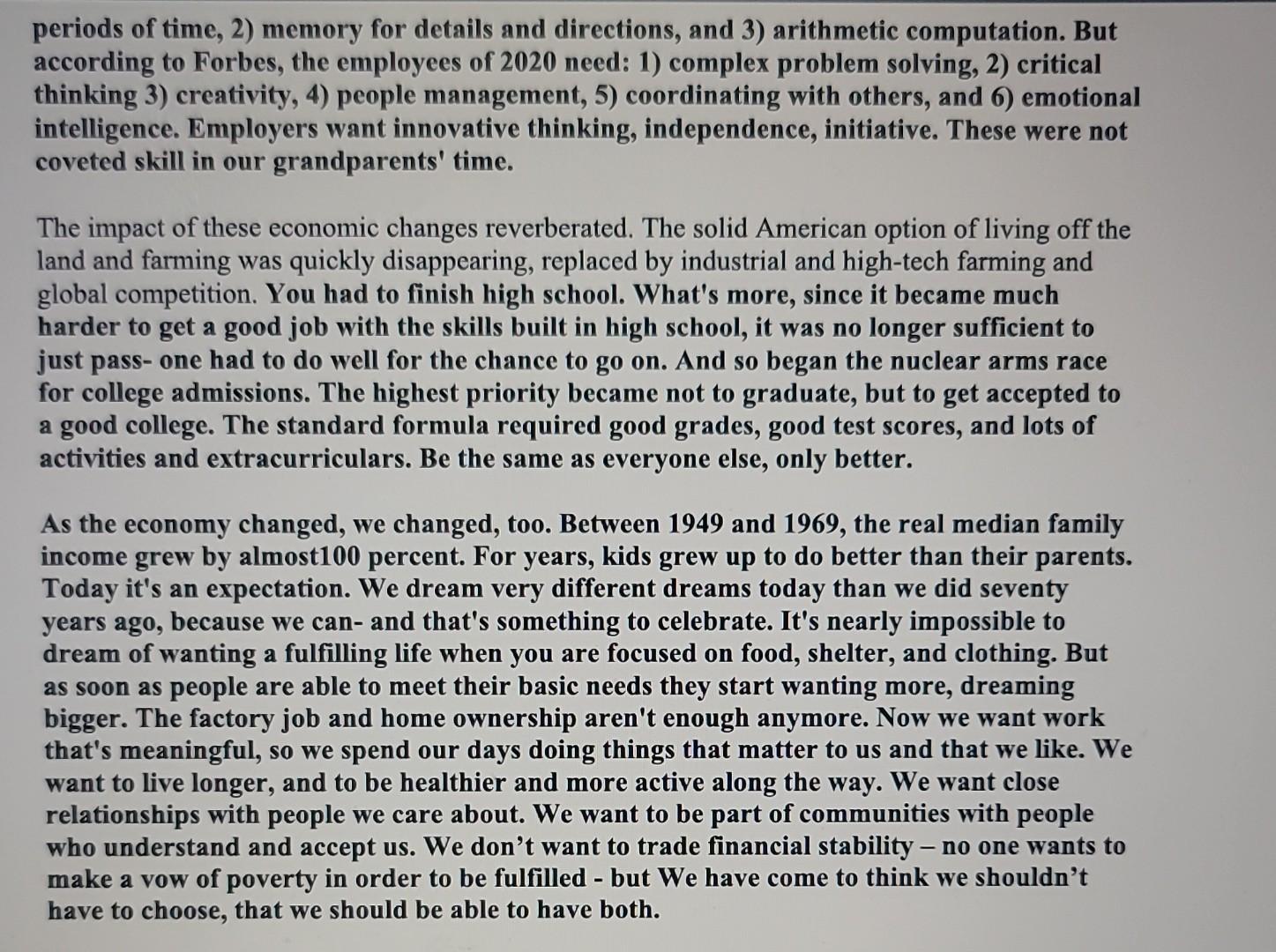Answered step by step
Verified Expert Solution
Question
1 Approved Answer
Diane Tavenner is the cofounder and CEO of Summit Public Schools which are included in America's Best High Schools in U.S. News & World





Diane Tavenner is the cofounder and CEO of Summit Public Schools which are included in America's Best High Schools in U.S. News & World Report, America's Most Challenging High Schools, and the world's top 10 most innovative companies in Education. She developed a school model centered on real-world experiences, self- direction, collaboration, and reflection - preparing all students to succeed in college, thrive in today's workplace, and lead secure and fulfilled lives. For the greater part of our country's history, most Americans lived in poverty. I can tell you from personal experience anyone who has ever been poor knows no one wants to be poor. When you are poor, your entire life is about surviving and trying to get yourself, or at least your kids, out of poverty. Early in the twentieth century, for the first time many, Americans were offered a solid value proposition- prepare your child for the industrial economy and pull your family out of poverty. Employers needed skilled workers to fill jobs, and high school-educated workers could get jobs that mover them into the middle class. Everyone won. One-room schoolhouses led by the most educated member of the town were replaced by a disciplined approach to ensure the basics were covered and students were prepared for factory life. The same subjects were taught the same way and for the same amount of time. Textbooks, a newer invention, were used to standardize knowledge. Bells, inspired by factory life, were meant to keep everyone on schedule, industrial lockers housed all that was personal, tests were given one time and one time only to sort and rank students. Yes, it looked like an assembly line, but most people were graduating to take just that type of job. The trade-offs were obvious. Conformity trumped individuality. The high-performers and the low-performers on the discrete skills valued in this system didn't get what they needed from high school, because it wasn't really designed for them, but rather for the "majority" in the middle. Acculturation superseded cultural history and family values. The parents' role in all of this was to ensure their child's compliance: go to school, sit down, and shut up - or else. That child might not have been able to bring his whole self to school, but what he was getting in return - a ticket to the middle class was worth it. They were counting on him to support the family, and perhaps someday even buy a house That was the dream. It was real and valuable. Not everyone would make it through high school, and that was okay, too. Even if the middle class was off limits, the farms still needed people to work them. If a high school diploma and a factory job weren't available, another honorable path was. Society needed a system to sort out who should have which job, so "tracking" kids through school wasn't a drawback--it was a win. Those few who were on the more elite track would sometimes go on to college, and ultimately become the managers of those who worked in the factories. Around the later part of the twentieth century, though, the value proposition changed. We began the shift from an industrial economy to a more global economy. It wasn't enough to get a high school degree and qualify for that factory job, because the economy became more service- and information-based. Employers changed what they wanted in workers. In the 1950s, the top skills employers wanted were: 1) the ability to work rapidly and for long periods of time, 2) memory for details and directions, and 3) arithmetic computation. But according to Forbes, the employees of 2020 need: 1) complex problem solving, 2) critical thinking 3) creativity, 4) people management, 5) coordinating with others, and 6) emotional intelligence. Employers want innovative thinking, independence, initiative. These were not coveted skill in our grandparents' time. The impact of these economic changes reverberated. The solid American option of living off the land and farming was quickly disappearing, replaced by industrial and high-tech farming and global competition. You had to finish high school. What's more, since it became much harder to get a good job with the skills built in high school, it was no longer sufficient to just pass- one had to do well for the chance to go on. And so began the nuclear arms race for college admissions. The highest priority became not to graduate, but to get accepted to a good college. The standard formula required good grades, good test scores, and lots of activities and extracurriculars. Be the same as everyone else, only better. As the economy changed, we changed, too. Between 1949 and 1969, the real median family income grew by almost 100 percent. For years, kids grew up to do better than their parents. Today it's an expectation. We dream very different dreams today than we did seventy years ago, because we can- and that's something to celebrate. It's nearly impossible to dream of wanting a fulfilling life when you are focused on food, shelter, and clothing. But as soon as people are able to meet their basic needs they start wanting more, dreaming bigger. The factory job and home ownership aren't enough anymore. Now we want work that's meaningful, so we spend our days doing things that matter to us and that we like. We want to live longer, and to be healthier and more active along the way. We want close relationships with people we care about. We want to be part of communities with people who understand and accept us. We don't want to trade financial stability - no one wants to make a vow of poverty in order to be fulfilled - but We have come to think we shouldn't have to choose, that we should be able to have both. Our country was founded on the premise that every American has a fundamental right to life, liberty, and the pursuit of happiness. The nation has yet to live up to that promise for many of its citizens. And, while the work is unevenly distributed, parents and our education system did work together time and again to prepare kids to pursue the life they wanted. But when things changed, we didn't adapt. In my first decade of teaching, I bore witness to the repercussions. Now, even in the "good schools" kids had to be lucky to get accepted into a top college, emerge unscathed, and feel prepared to enter the next phase of their life. For the schools that already weren't working for kids and families, the odds were impossible. It was clear to me that luck was not a smart national strategy. There had to be a better way. 4. According to the article, what do employers want from workers? What's your thoughts about these desired traits? How do you want to prepare yourself during college based on this finding? 5. According to this article, today people dream bigger than their parents, factory job and home ownership aren't enough anymore. What else do we want? What do you learn from these wants? How do you want to plan your life after reading this part?
Step by Step Solution
★★★★★
3.58 Rating (151 Votes )
There are 3 Steps involved in it
Step: 1
4 According to the article employers in the global economy of today desire complex problemsolving critical thinking creativity people management coordinating with others and emotional intelligence fro...
Get Instant Access to Expert-Tailored Solutions
See step-by-step solutions with expert insights and AI powered tools for academic success
Step: 2

Step: 3

Ace Your Homework with AI
Get the answers you need in no time with our AI-driven, step-by-step assistance
Get Started


